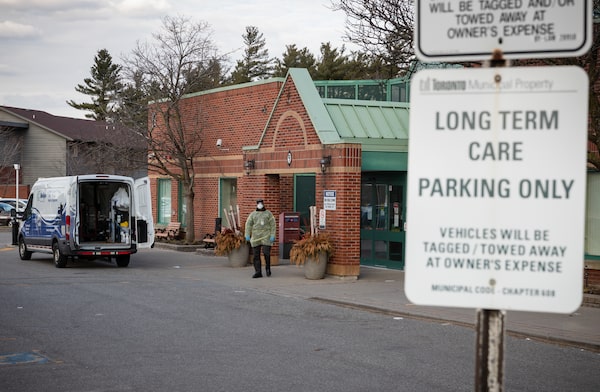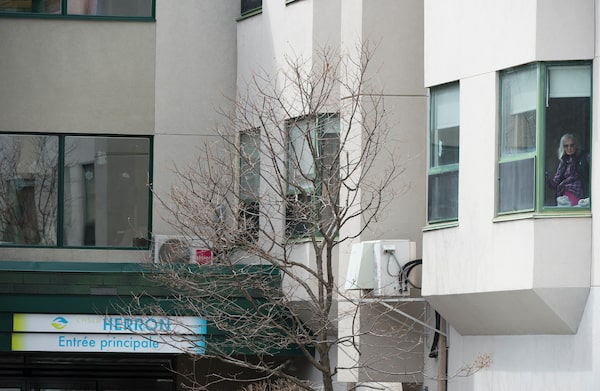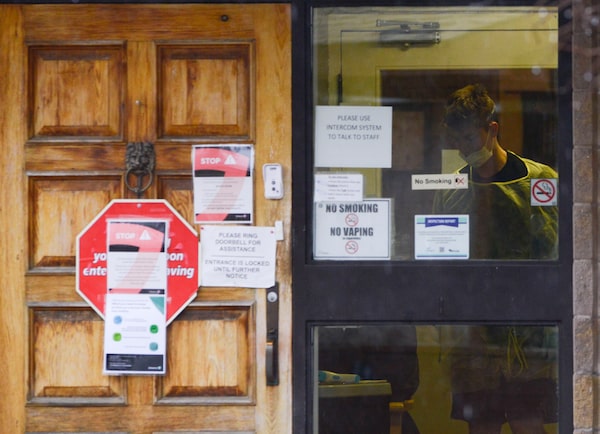
On April 1, 2020, a Medigas worker delivers new oxygen concentrators to the Seven Oaks long term care home in Scarborough, Ontario, where several residents have died due to COVID-19 and dozens more are infected.Melissa Tait/The Globe and Mail
Ontario says it will rely on volunteers and recruit new workers to fill growing employment gaps in long-term care and group homes during the COVID-19 pandemic, as severe staffing shortages are being reported across the province.
Ontario Health Minister Christine Elliott said the province is recruiting health care workers through a new online portal and has received thousands of applications from retired nurses, medical students and internationally trained professionals.
“They want to do the work on the front lines,” she said.
Concerns around staffing in long-term care and group homes continue to grow as more homes are reporting outbreaks among both residents and staff. On Saturday, Ontario reported a total of 79 outbreaks in long-term care homes in the province. Numerous facilities have put out public calls for staffing help, saying they are unable to meet the needs of residents.
The coronavirus SARS-CoV-2 can cause an illness known as COVID-19. The symptoms include fever and dry cough.
Unlike a common cold, people with COVID-19 generally do not have a runny nose or a sore throat. Remember that although the virus can seriously impact all ages, older people are at higher risk of developing severe illness.
Read how to best keep seniors and children safe.
According to a large study in China, the vast majority of those infected with the novel coronavirus:
- 81 per cent of patients have mild symptoms
- 14 per cent of patients had severe symptoms, including trouble breathing
- Just under 5 per cent of patients suffered critical illness, meaning they needed to be on a respirator
The overall fatality rate in China is 2.3 per cent.
However, it is not yet clear how deadly COVID-19 is because many mild cases have likely gone undetected. Remember, you are far more likely to have a cold or even the flu than COVID-19. In all cases, the treatment is the same – you treat the symptoms with fever-reducing medication such as acetaminophen (Tylenol) or ibuprofen (Advil, Motrin) and bed rest. You should not treat fever with ASA-based painkillers such as Aspirin, especially in children. Antibiotics do not help; they only work for bacterial illnesses.
Read our daily coronavirus newsletter for updates.
Check the World Health Organization’s information page for more details on the virus, and The Globe and Mail’s guide of what health officials say is helpful for the public to do or not do about it.
At Participation House in Markham, Ont., a facility that serves adults with developmental and physical disabilities, most of the home’s personal support workers (PSWs) and caregivers walked off the job last week after a COVID-19 outbreak, said a member of the board of directors, Debra McLaughlin. The facility is now down to two PSWs from eight, and 10 caregivers from 35 during each shift, she said, with management filling in. As of Sunday, 12 residents and six staff tested positive for COVID-19, with testing continuing.
“Staffing shortages have persisted throughout the weekend with as few as six people looking after the 42 residents at times,” said executive director Shelley Brillinger.
“What happened in Markham is heartbreaking. We just can’t abandon the most vulnerable," Premier Doug Ford said Saturday.
Miranda Ferrier, president of the Ontario Personal Support Workers Association, which represents 40,000 people, said staffing shortages range significantly from home to home.
“[Workers] are scared, that’s why they are walking away … because they may not have the appropriate [personal protective equipment] in the home," she said.
House approves emergency wage subsidy, senate expected to pass this evening
Officials investigate after 31 die in Montreal nursing home during coronavirus pandemic
Ms. Ferrier said some employment agencies are now offering up to $30 an hour for PSWs in long-term care homes, compared with average wages of around $18 to $21. One home-care company is offering $35 an hour to work with COVID-19 patients.
She said that means some PSWs will jump ship, leaving further shortages in their wake. “We didn’t have the staff prior to the pandemic. That’s the problem,” she said.
In Hagersville, Ont., located about a half-hour drive southwest of Hamilton, 13 residents at Anson Place have died in a COVID-19 outbreak. Executive director Lisa Roth said in a statement that 51 residents and 30 staff have tested positive. The facility has hired additional care and cleaning staff, the statement said.

An elderly woman looks out from Maison Herron, a long term care home in the Montreal suburb of Dorval, Que., on Saturday, April 11, 2020, as COVID-19 cases rise in Canada and around the world.Graham Hughes/The Canadian Press
Tracey Savelli, whose 86-year-old mother, Ida Monti, is at Anson Place, said workers are doing everything they can, but the facility seems overwhelmed.
“They’re doing the best they can do under a really tough situation,” Ms. Savelli said. “These girls are bombarded. This thing broke out so fast.”
Ms. Savelli’s mother does not have COVID-19, but her family has resigned themselves to the reality that she will likely fall ill. “This is what will probably take her,” she said. “If she gets this, I doubt very much that she will be able to work through it.”
Catherine Coyle is facing similar fears about her 97-year-old mother, who lives at Almonte Country Haven, an 82-bed facility about 30 minutes west of Ottawa. Eleven of its residents have died of COVID-19-related complications, while another 21 have tested positive for the virus. At least one staff member has also been infected.
Ms. Coyle says her mother, who has severe dementia, receives excellent care, but she worries that the outbreak is leaving workers stretched.
“There was already a chronic shortage of staff before this began,” Ms. Coyle said. “The concern is, how much longer can the staff maintain the pace?"

The entrance to the Almonte Country Haven long-term care home is shown in Almonte, Ont. on Thursday, April 9, 2020. The facility has had 11 deaths due to COVID-19.Sean Kilpatrick/The Canadian Press
The home won’t say if there is a staffing shortage, but there are hiring signs outside the building. Administrator Carolyn Della Foresta said Saturday that the home is “welcoming several staff members back to the team,” after receiving two negative tests or if they are symptom-free for 24 hours.
Ms. Coyle said her family thought medically trained military staff could help with sanitizing, containment, or even meal preparation. “At what point does it become a worst-case scenario?” Ms. Coyle said.
“Our fear is that we’re just leaving our loved one there for this to sweep through. We feel helpless.”
Brendan Kelly said a friend of his is also in the Almonte home, sharing a room with two other women. His friend, 70, recently tested positive for COVID-19, he said.
“The quarantine is just a bed sheet thrown around her,” he said. “She hasn’t been cleaned in the month of April.”
He said she’s been in the home since having a brain tumour removed and after suffering a mild stroke, and that she has had nothing bad to say about the staff who remain.
“There’s physically not enough people for the workload. They’re doing the best they can,” Mr. Kelly said. “It’s just been a nightmare.”

A worker is shown through a window at the Almonte Country Haven long-term care home in Almonte, Ont. on Thursday, April 9, 2020. The facility has had 11 deaths due to COVID-19.Sean Kilpatrick/The Canadian Press
Asked about military aid on Saturday, Ms. Elliott said: "Everything is on the table. I don’t think military aid is required at this point because we have had thousands of medical professionals who have come forward that are willing to help out.”
Ms. Elliott said the “vast majority” of people working in long-term care and group settings are fulfilling their duties, but they want more personal protective equipment that allows them to safely do their jobs. She said the province is working around the clock on procuring essential supplies, such as masks and gowns.
The Public Health Agency of Canada on Saturday issued a list of federal guidelines aimed at curbing the spread of COVID-19 in long-term care homes, largely focused around limiting visitors at those facilities and ensuring anyone entering them doesn’t pose a risk to residents.
Most significantly, the guidelines say staff and volunteers should not be permitted to work at multiple facilities – a practice that has already been identified as a factor in outbreaks at long-term care homes. It is common for low-wage workers at care homes to work multiple jobs to make ends meet.
British Columbia prohibited staff from working at more than one long-term facility three weeks ago, while Alberta announced a similar measure on Friday, though it won’t be implemented until late next week. Ontario has also recommended against working in multiple homes, and Ms. Elliott said Saturday that the province is looking at doing more.
“That is a liability,” she said. "That’s going to be another key method of keeping COVID-19 out of long-term care homes.”
As is Sunday, 12 residents and six staff tested positive for COVID-19, with testing continuing. “Staffing shortages have persisted throughout the weekend with as few as six people looking after the 42 residents at times,” said executive director Shelley Brillinger.
 Laura Stone
Laura Stone James Keller
James Keller